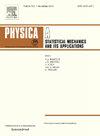基于快速局部标签扩展的加权层聚合多路网络社区检测方法
IF 2.8
3区 物理与天体物理
Q2 PHYSICS, MULTIDISCIPLINARY
Physica A: Statistical Mechanics and its Applications
Pub Date : 2025-04-29
DOI:10.1016/j.physa.2025.130639
引用次数: 0
摘要
多路复用网络中的社区检测已经成为一个重要的研究领域,因为它能够捕获多层互连数据之间的复杂交互。尽管取得了巨大的进步,但现有的方法往往面临着严峻的挑战,包括计算时间、分辨率限制、自由参数调整、训练模型等。为了克服这些限制,本文提出了LCDMN (Layer-Coupled Diffusion for Multiplex Networks)算法,用于多路网络中准确、高效的社区检测。LCDMN采用动态缩放和层耦合来自适应识别不同网络配置的社区结构,提高了对网络密度和结构模糊性的弹性。LCDMN通过以下方式解决层多样性的挑战:(1)基于层相关性、层节点活动方差和吸引力等关键参数对层进行动态加权;(2)开发一种鲁棒的节点评分方法;(3)将多路网络的层聚合成单层加权图;(4)采用带有处理重叠节点机制的标签扩散方法;(5)通过动态合并过程优化社区结构,该过程在执行过程中自适应调整层贡献和社区边界,确保上下文敏感的结构歧义解决。利用网络拓扑和结构度量对节点和边缘进行评分,有效地将其纳入标签扩散过程中,以检测初始社区。该方法平衡了计算效率和精度,能够在复杂网络中检测内聚和定义良好的社区。在现实世界和合成复用网络上的实验评估表明,LCDMN在标准化互信息(NMI)、调整兰德指数(ARI)和模块化方面始终优于最先进的方法,如Infomap、MDLPA、MPBTV、LART、DGFM3和GenLouvain。本文章由计算机程序翻译,如有差异,请以英文原文为准。
Weighted layer aggregation with fast and local label expanding method for community detection in multiplex networks
Community detection in multiplex networks has emerged as a crucial research area due to its ability to capture complex interactions across multiple layers of interconnected data. Despite significant advancements, existing methods often face critical challenges, including computational time, resolution limit, free parameter tuning, training models, etc. To overcome these limitations, this paper presents LCDMN (Layer-Coupled Diffusion for Multiplex Networks) algorithm designed for accurate and efficient community detection in multiplex networks. LCDMN employs dynamic scaling and layer coupling to adaptively identify community structures across diverse network configurations, offering improved resilience to network’s density and structural ambiguity. LCDMN addresses the challenges of layer diversity by: (1) dynamically weighting layers based on critical parameters such as layer correlation, layer nodes activity variance, and attractiveness, (2) developing a robust node scoring method, (3) the aggregating layers of multiplex network into a single-layer, weighted graph, (4) employing a label diffusion approach with mechanisms for handling overlapping nodes, and (5) refining community structures through a dynamic merging process that adaptively adjusts layer contributions and community boundaries during execution, ensuring context-sensitive resolution of structural ambiguity. Nodes and edges are scored using network topology and structural metrics to efficiently incorporate in label diffusion process for detecting initial communities. The approach balances computational efficiency with precision, enabling the detection of cohesive and well-defined communities in complex networks. Experimental evaluations on real-world and synthetic multiplex networks demonstrate that LCDMN consistently outperforms state-of-the-art methods, such as Infomap, MDLPA, MPBTV, LART, DGFM3 and GenLouvain, in terms of Normalized Mutual Information (NMI), Adjusted Rand Index (ARI), and modularity.
求助全文
通过发布文献求助,成功后即可免费获取论文全文。
去求助
来源期刊
CiteScore
7.20
自引率
9.10%
发文量
852
审稿时长
6.6 months
期刊介绍:
Physica A: Statistical Mechanics and its Applications
Recognized by the European Physical Society
Physica A publishes research in the field of statistical mechanics and its applications.
Statistical mechanics sets out to explain the behaviour of macroscopic systems by studying the statistical properties of their microscopic constituents.
Applications of the techniques of statistical mechanics are widespread, and include: applications to physical systems such as solids, liquids and gases; applications to chemical and biological systems (colloids, interfaces, complex fluids, polymers and biopolymers, cell physics); and other interdisciplinary applications to for instance biological, economical and sociological systems.

 求助内容:
求助内容: 应助结果提醒方式:
应助结果提醒方式:


